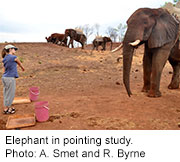- Skip Storing This Everyday Product in the Fridge Door
- Green Tea + B3 Pairing May Boost Brain Health
- Navigating Your Midlife Crisis: Embracing New Possibilities
- City Raccoons Showing Signs of Domestication
- Mapping the Exposome: Science Broadens Focus to Environmental Disease Triggers
- One Week Less on Social Media Linked to Better Mental Health
- Your Brain Changes in Stages as You Age, Study Finds
- Some Suicide Victims Show No Typical Warning Signs, Study Finds
- ByHeart Formula Faces Lawsuits After Babies Sickened With Botulism
- Switch to Vegan Diet Could Cut Your Greenhouse Gas Emissions in Half
Elephants Understand Pointing, Research Shows


THURSDAY, Oct. 10Elephants don’t require training to understand what it means when people point to something and are able to use it as a cue to find food, new research finds.
The finding is especially noteworthy given that many great apes do not understand what their human caretakers mean when they point to something, according to the study, which was published in the Oct. 10 issue of the journal Current Biology.
“By showing that African elephants spontaneously understand human pointing, without any training to do so, we have shown that the ability to understand pointing is not uniquely human but has also evolved in a lineage of animal very remote from the primates,” Richard Byrne, of the University of St. Andrews in Scotland, said in a journal news release.
“What elephants share with humans is that they live in an elaborate and complex network in which support, empathy and help for others are critical for survival,” Byrne said. “It may be only in such a society that the ability to follow pointing has adaptive value, or, more generally, elephant society may have selected for an ability to understand when others are trying to communicate with them, and they are thus able to work out what pointing is about when they see it.”
Byrne and his colleagues studied elephants who take tourists on rides in southern Africa. The elephants were trained to follow vocal commands, but hadn’t been trained to understand the meaning of pointing.
“Of course, we always hoped that our elephants would be able to learn to follow human pointing, or we’d not have carried out the experiments,” study first author Anna Smet said in the news release. “What really surprised us is that they did not apparently need to learn anything. Their understanding was as good on the first trial as the last, and we could find no sign of learning over the experiment.”
The findings help explain how humans have been able to use wild-caught elephants as work animals for thousands of years.
“Elephants are cognitively much more like us than has been realized, making them able to understand our characteristic way of indicating things in the environment by pointing,” Byrne said. “This means that pointing is not a uniquely human part of the language system.”
It’s possible, the researchers said, that elephants might use their long trunk to do something like pointing.
More information
The World Wildlife Fund has more about elephants.
Source: HealthDay
Copyright © 2025 HealthDay. All rights reserved.










